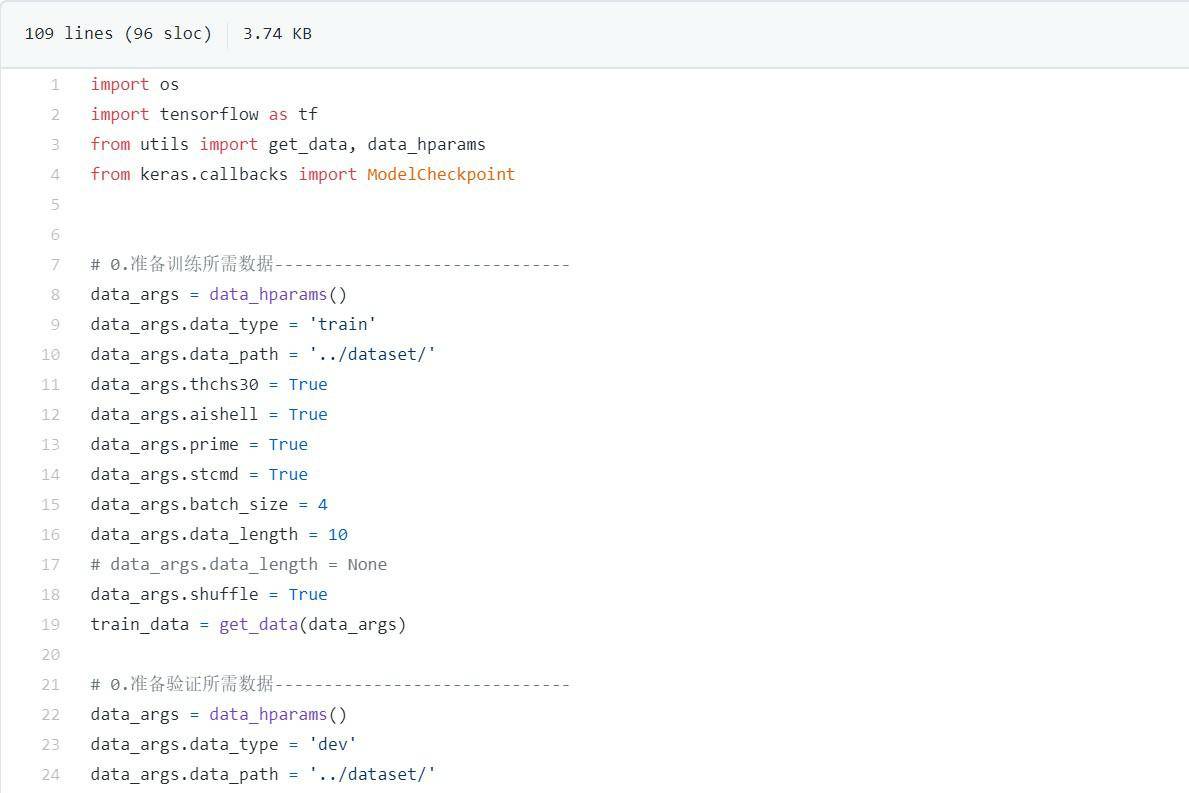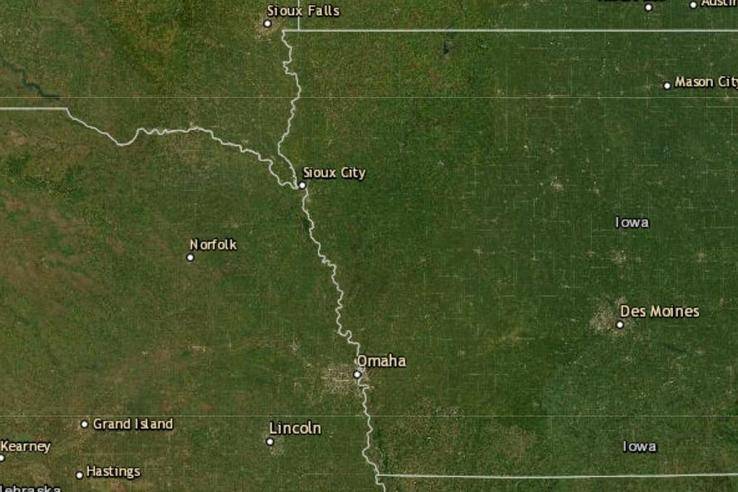



【Demo】基于深度学习的中文语音识别系统

文件列表(压缩包大小 71.70M)
免费
概述
基于深度学习的中文语音识别系统
包括基于深度学习的声学模型和基于深度学习的语言模型
1. Introduction
该系统实现了基于深度框架的语音识别中的声学模型和语言模型建模,其中声学模型包括CNN-CTC、GRU-CTC、CNN-RNN-CTC,语言模型包含transformer、CBHG,数据集包含stc、primewords、Aishell、thchs30四个数据集。
本系统更整体介绍:https://blog.csdn.net/chinatelecom08/article/details/82557715
本项目现已训练一个迷你的语音识别系统,将项目下载到本地上,下载thchs数据集并解压至data,运行test.py,不出意外能够进行识别,结果如下:
the 0 th example.
文本结果: lv4 shi4 yang2 chun1 yan1 jing3 da4 kuai4 wen2 zhang1 de di3 se4 si4 yue4 de lin2 luan2 geng4 shi4 lv4 de2 xian1 huo2 xiu4 mei4 shi1 yi4 ang4 ran2
原文结果: lv4 shi4 yang2 chun1 yan1 jing3 da4 kuai4 wen2 zhang1 de di3 se4 si4 yue4 de lin2 luan2 geng4 shi4 lv4 de2 xian1 huo2 xiu4 mei4 shi1 yi4 ang4 ran2
原文汉字: 绿是阳春烟景大块文章的底色四月的林峦更是绿得鲜活秀媚诗意盎然
识别结果: 绿是阳春烟景大块文章的底色四月的林峦更是绿得鲜活秀媚诗意盎然
若自己建立模型则需要删除现有模型,重新配置参数训练,具体实现流程参考本页最后。
2. 声学模型
声学模型采用CTC进行建模,采用CNN-CTC、GRU-CTC、FSMN等模型model_speech,采用keras作为编写框架。
- 论文地址:http://www.infocomm-journal.com/dxkx/CN/article/openArticlePDFabs.jsp?id=166970
- tutorial:https://blog.csdn.net/chinatelecom08/article/details/85013535
3. 语言模型
新增基于self-attention结构的语言模型model_language\transformer.py,该模型已经被证明有强于其他框架的语言表达能力。
- 论文地址:https://arxiv.org/abs/1706.03762。
- tutorial:https://blog.csdn.net/chinatelecom08/article/details/85051817
基于CBHG结构的语言模型model_language\cbhg.py,该模型之前用于谷歌声音合成,移植到该项目中作为基于神经网络的语言模型。
- 原理地址:https://github.com/crownpku/Somiao-Pinyin
- tutorial:https://blog.csdn.net/chinatelecom08/article/details/85048019
4. 数据集
包括stc、primewords、Aishell、thchs30四个数据集,共计约430小时, 相关链接:http://www.openslr.org/resources.php
| Name | train | dev | test |
|---|---|---|---|
| aishell | 120098 | 14326 | 7176 |
| primewords | 40783 | 5046 | 5073 |
| thchs-30 | 10000 | 893 | 2495 |
| st-cmd | 10000 | 600 | 2000 |
数据标签整理在data路径下,其中primewords、st-cmd目前未区分训练集测试集。
若需要使用所有数据集,只需解压到统一路径下,然后设置utils.py中datapath的路径即可。
与数据相关参数在utils.py中:
- data_type: train, test, dev
- data_path: 对应解压数据的路径
- thchs30, aishell, prime, stcmd: 是否使用该数据集
- batch_size: batch_size
- data_length: 我自己做实验时写小一些看效果用的,正常使用设为None即可
- shuffle:正常训练设为True,是否打乱训练顺序
def data_hparams():
params = tf.contrib.training.HParams(
# vocab
data_type = 'train',
data_path = 'data/',
thchs30 = True,
aishell = True,
prime = False,
stcmd = False,
batch_size = 1,
data_length = None,
shuffle = False)
return params
5. 配置
使用train.py文件进行模型的训练。 声学模型可选cnn-ctc、gru-ctc,只需修改导入路径即可:
from model_speech.cnn_ctc import Am, am_hparams
from model_speech.gru_ctc import Am, am_hparams
语言模型可选transformer和cbhg:
from model_language.transformer import Lm, lm_hparams
from model_language.cbhg import Lm, lm_hparams
模型识别
使用test.py检查模型识别效果。 模型选择需和训练一致。
一个简单的例子
1. 声学模型训练
train.py文件
import osimport tensorflow as tffrom utils import get_data, data_hparams
# 准备训练所需数据data_args = data_hparams()data_args.data_length = 10train_data = get_data(data_args)
# 1.声学模型训练-----------------------------------from model_speech.cnn_ctc import Am, am_hparamsam_args = am_hparams()am_args.vocab_size = len(train_data.am_vocab)am = Am(am_args)if os.path.exists('logs_am/model.h5'):
print('load acoustic model...')
am.ctc_model.load_weights('logs_am/model.h5')
epochs = 10batch_num = len(train_data.wav_lst) // train_data.batch_size
for k in range(epochs):
print('this is the', k+1, 'th epochs trainning !!!')
#shuffle(shuffle_list)
batch = train_data.get_am_batch()
am.ctc_model.fit_generator(batch, steps_per_epoch=batch_num, epochs=1)
am.ctc_model.save_weights('logs_am/model.h5')
get source list...
load thchs_train.txt data...
100%|████████████████████████████████████████████████████████████████████████| 10000/10000 [00:00<00:00, 236865.96it/s]
load aishell_train.txt data...
100%|██████████████████████████████████████████████████████████████████████| 120098/120098 [00:00<00:00, 260863.15it/s]
make am vocab...
100%|████████████████████████████████████████████████████████████████████████████████| 10/10 [00:00<00:00, 9986.44it/s]
make lm pinyin vocab...
100%|████████████████████████████████████████████████████████████████████████████████| 10/10 [00:00<00:00, 9946.18it/s]
make lm hanzi vocab...
100%|████████████████████████████████████████████████████████████████████████████████| 10/10 [00:00<00:00, 9950.90it/s]
Using TensorFlow backend.
_________________________________________________________________
Layer (type) Output Shape Param #
=================================================================
the_inputs (InputLayer) (None, None, 200, 1) 0
_________________________________________________________________
conv2d_1 (Conv2D) (None, None, 200, 32) 320
_________________________________________________________________
batch_normalization_1 (Batch (None, None, 200, 32) 128
_________________________________________________________________
conv2d_2 (Conv2D) (None, None, 200, 32) 9248
_________________________________________________________________
batch_normalization_2 (Batch (None, None, 200, 32) 128
_________________________________________________________________
max_pooling2d_1 (MaxPooling2 (None, None, 100, 32) 0
_________________________________________________________________
conv2d_3 (Conv2D) (None, None, 100, 64) 18496
_________________________________________________________________
batch_normalization_3 (Batch (None, None, 100, 64) 256
_________________________________________________________________
conv2d_4 (Conv2D) (None, None, 100, 64) 36928
_________________________________________________________________
batch_normalization_4 (Batch (None, None, 100, 64) 256
_________________________________________________________________
max_pooling2d_2 (MaxPooling2 (None, None, 50, 64) 0
_________________________________________________________________
conv2d_5 (Conv2D) (None, None, 50, 128) 73856
_________________________________________________________________
batch_normalization_5 (Batch (None, None, 50, 128) 512
_________________________________________________________________
conv2d_6 (Conv2D) (None, None, 50, 128) 147584
_________________________________________________________________
batch_normalization_6 (Batch (None, None, 50, 128) 512
_________________________________________________________________
max_pooling2d_3 (MaxPooling2 (None, None, 25, 128) 0
_________________________________________________________________
conv2d_7 (Conv2D) (None, None, 25, 128) 147584
_________________________________________________________________
batch_normalization_7 (Batch (None, None, 25, 128) 512
_________________________________________________________________
conv2d_8 (Conv2D) (None, None, 25, 128) 147584
_________________________________________________________________
batch_normalization_8 (Batch (None, None, 25, 128) 512
_________________________________________________________________
conv2d_9 (Conv2D) (None, None, 25, 128) 147584
_________________________________________________________________
batch_normalization_9 (Batch (None, None, 25, 128) 512
_________________________________________________________________
conv2d_10 (Conv2D) (None, None, 25, 128) 147584
_________________________________________________________________
batch_normalization_10 (Batc (None, None, 25, 128) 512
_________________________________________________________________
reshape_1 (Reshape) (None, None, 3200) 0
_________________________________________________________________
dense_1 (Dense) (None, None, 256) 819456
_________________________________________________________________
dense_2 (Dense) (None, None, 230) 59110
=================================================================
Total params: 1,759,174
Trainable params: 1,757,254
Non-trainable params: 1,920
_________________________________________________________________
load acoustic model...
2.语言模型训练
# 2.语言模型训练-------------------------------------------from model_language.transformer import Lm, lm_hparams
lm_args = lm_hparams()lm_args.input_vocab_size = len(train_data.pny_vocab)lm_args.label_vocab_size = len(train_data.han_vocab)lm = Lm(lm_args)
epochs = 10with lm.graph.as_default():
saver =tf.train.Saver()with tf.Session(graph=lm.graph) as sess:
merged = tf.summary.merge_all()
sess.run(tf.global_variables_initializer())
if os.path.exists('logs_lm/model.meta'):
print('loading language model...')
saver.restore(sess, 'logs_lm/model')
writer = tf.summary.FileWriter('logs_lm/tensorboard', tf.get_default_graph())
for k in range(epochs):
total_loss = 0
batch = train_data.get_lm_batch()
for i in range(batch_num):
input_batch, label_batch = next(batch)
feed = {lm.x: input_batch, lm.y: label_batch}
cost,_ = sess.run([lm.mean_loss,lm.train_op], feed_dict=feed)
total_loss += cost
if (k * batch_num + i) % 10 == 0:
rs=sess.run(merged, feed_dict=feed)
writer.add_summary(rs, k * batch_num + i)
if (k+1) % 5 == 0:
print('epochs', k+1, ': average loss = ', total_loss/batch_num)
saver.save(sess, 'logs_lm/model')
writer.close()
loading language model...
INFO:tensorflow:Restoring parameters from logs_lm/model
3. 模型测试
整合声学模型和语言模型 test.py文件
定义解码器
import osimport tensorflow as tfimport numpy as npfrom keras import backend as K
# 定义解码器------------------------------------def decode_ctc(num_result, num2word):
result = num_result[:, :, :]
in_len = np.zeros((1), dtype = np.int32)
in_len[0] = result.shape[1]
r = K.ctc_decode(result, in_len, greedy = True, beam_width=10, top_paths=1)
r1 = K.get_value(r[0][0])
r1 = r1[0]
text = []
for i in r1:
text.append(num2word[i])
return r1, text
准备测试数据
# 0. 准备解码所需字典,需和训练一致,也可以将字典保存到本地,直接进行读取from utils import get_data, data_hparamsdata_args = data_hparams()data_args.data_length = 10 # 重新训练需要注释该行train_data = get_data(data_args)
# 3. 准备测试所需数据, 不必和训练数据一致,通过设置data_args.data_type测试,# 此处应设为'test',我用了'train'因为演示模型较小,如果使用'test'看不出效果,# 且会出现未出现的词。data_args.data_type = 'train'test_data = get_data(data_args)am_batch = test_data.get_am_batch()lm_batch = test_data.get_lm_batch()
get source list...
load thchs_train.txt data...
100%|████████████████████████████████████████████████████████████████████████| 10000/10000 [00:00<00:00, 226097.06it/s]
load aishell_train.txt data...
100%|██████████████████████████████████████████████████████████████████████| 120098/120098 [00:00<00:00, 226827.96it/s]
make am vocab...
100%|████████████████████████████████████████████████████████████████████████████████| 10/10 [00:00<00:00, 9950.90it/s]
make lm pinyin vocab...
100%|██████████████████████████████████████████████████████████████████████████████████████████| 10/10 [00:00<?, ?it/s]
make lm hanzi vocab...
100%|████████████████████████████████████████████████████████████████████████████████| 10/10 [00:00<00:00, 9953.26it/s]
加载声学模型和语言模型
# 1.声学模型-----------------------------------from model_speech.cnn_ctc import Am, am_hparams
am_args = am_hparams()am_args.vocab_size = len(train_data.am_vocab)am = Am(am_args)print('loading acoustic model...')am.ctc_model.load_weights('logs_am/model.h5')
# 2.语言模型-------------------------------------------from model_language.transformer import Lm, lm_hparams
lm_args = lm_hparams()lm_args.input_vocab_size = len(train_data.pny_vocab)lm_args.label_vocab_size = len(train_data.han_vocab)print('loading language model...')lm = Lm(lm_args)sess = tf.Session(graph=lm.graph)with lm.graph.as_default():
saver =tf.train.Saver()with sess.as_default():
saver.restore(sess, 'logs_lm/model')
_________________________________________________________________
Layer (type) Output Shape Param #
=================================================================
the_inputs (InputLayer) (None, None, 200, 1) 0
_________________________________________________________________
conv2d_11 (Conv2D) (None, None, 200, 32) 320
_________________________________________________________________
batch_normalization_11 (Batc (None, None, 200, 32) 128
_________________________________________________________________
conv2d_12 (Conv2D) (None, None, 200, 32) 9248
_________________________________________________________________
batch_normalization_12 (Batc (None, None, 200, 32) 128
_________________________________________________________________
max_pooling2d_4 (MaxPooling2 (None, None, 100, 32) 0
_________________________________________________________________
conv2d_13 (Conv2D) (None, None, 100, 64) 18496
_________________________________________________________________
batch_normalization_13 (Batc (None, None, 100, 64) 256
_________________________________________________________________
conv2d_14 (Conv2D) (None, None, 100, 64) 36928
_________________________________________________________________
batch_normalization_14 (Batc (None, None, 100, 64) 256
_________________________________________________________________
max_pooling2d_5 (MaxPooling2 (None, None, 50, 64) 0
_________________________________________________________________
conv2d_15 (Conv2D) (None, None, 50, 128) 73856
_________________________________________________________________
batch_normalization_15 (Batc (None, None, 50, 128) 512
_________________________________________________________________
conv2d_16 (Conv2D) (None, None, 50, 128) 147584
_________________________________________________________________
batch_normalization_16 (Batc (None, None, 50, 128) 512
_________________________________________________________________
max_pooling2d_6 (MaxPooling2 (None, None, 25, 128) 0
_________________________________________________________________
conv2d_17 (Conv2D) (None, None, 25, 128) 147584
_________________________________________________________________
batch_normalization_17 (Batc (None, None, 25, 128) 512
_________________________________________________________________
conv2d_18 (Conv2D) (None, None, 25, 128) 147584
_________________________________________________________________
batch_normalization_18 (Batc (None, None, 25, 128) 512
_________________________________________________________________
conv2d_19 (Conv2D) (None, None, 25, 128) 147584
_________________________________________________________________
batch_normalization_19 (Batc (None, None, 25, 128) 512
_________________________________________________________________
conv2d_20 (Conv2D) (None, None, 25, 128) 147584
_________________________________________________________________
batch_normalization_20 (Batc (None, None, 25, 128) 512
_________________________________________________________________
reshape_2 (Reshape) (None, None, 3200) 0
_________________________________________________________________
dense_3 (Dense) (None, None, 256) 819456
_________________________________________________________________
dense_4 (Dense) (None, None, 230) 59110
=================================================================
Total params: 1,759,174
Trainable params: 1,757,254
Non-trainable params: 1,920
_________________________________________________________________
loading acoustic model...
loading language model...
INFO:tensorflow:Restoring parameters from logs_lm/model
使用语音识别系统
for i in range(5):
print('\n the ', i, 'th example.')
# 载入训练好的模型,并进行识别
inputs, outputs = next(am_batch)
x = inputs['the_inputs']
y = inputs['the_labels'][0]
result = am.model.predict(x, steps=1)
# 将数字结果转化为文本结果
_, text = decode_ctc(result, train_data.am_vocab)
text = ' '.join(text)
print('文本结果:', text)
print('原文结果:', ' '.join([train_data.am_vocab[int(i)] for i in y]))
with sess.as_default():
_, y = next(lm_batch)
text = text.strip('\n').split(' ')
x = np.array([train_data.pny_vocab.index(pny) for pny in text])
x = x.reshape(1, -1)
preds = sess.run(lm.preds, {lm.x: x})
got = ''.join(train_data.han_vocab[idx] for idx in preds[0])
print('原文汉字:', ''.join(train_data.han_vocab[idx] for idx in y[0]))
print('识别结果:', got)sess.close()
the 0 th example.
文本结果: lv4 shi4 yang2 chun1 yan1 jing3 da4 kuai4 wen2 zhang1 de di3 se4 si4 yue4 de lin2 luan2 geng4 shi4 lv4 de2 xian1 huo2 xiu4 mei4 shi1 yi4 ang4 ran2
原文结果: lv4 shi4 yang2 chun1 yan1 jing3 da4 kuai4 wen2 zhang1 de di3 se4 si4 yue4 de lin2 luan2 geng4 shi4 lv4 de2 xian1 huo2 xiu4 mei4 shi1 yi4 ang4 ran2
原文汉字: 绿是阳春烟景大块文章的底色四月的林峦更是绿得鲜活秀媚诗意盎然
识别结果: 绿是阳春烟景大块文章的底色四月的林峦更是绿得鲜活秀媚诗意盎然
the 1 th example.
文本结果: ta1 jin3 ping2 yao1 bu4 de li4 liang4 zai4 yong3 dao4 shang4 xia4 fan1 teng2 yong3 dong4 she2 xing2 zhuang4 ru2 hai3 tun2 yi4 zhi2 yi3 yi1 tou2 de you1 shi4 ling3 xian1
原文结果: ta1 jin3 ping2 yao1 bu4 de li4 liang4 zai4 yong3 dao4 shang4 xia4 fan1 teng2 yong3 dong4 she2 xing2 zhuang4 ru2 hai3 tun2 yi4 zhi2 yi3 yi1 tou2 de you1 shi4 ling3 xian1
原文汉字: 他仅凭腰部的力量在泳道上下翻腾蛹动蛇行状如海豚一直以一头的优势领先
识别结果: 他仅凭腰部的力量在泳道上下翻腾蛹动蛇行状如海豚一直以一头的优势领先
the 2 th example.
文本结果: pao4 yan3 da3 hao3 le zha4 yao4 zen3 me zhuang1 yue4 zheng4 cai2 yao3 le yao3 ya2 shu1 di4 tuo1 qu4 yi1 fu2 guang1 bang3 zi chong1 jin4 le shui3 cuan4 dong4
原文结果: pao4 yan3 da3 hao3 le zha4 yao4 zen3 me zhuang1 yue4 zheng4 cai2 yao3 le yao3 ya2 shu1 di4 tuo1 qu4 yi1 fu2 guang1 bang3 zi chong1 jin4 le shui3 cuan4 dong4
原文汉字: 炮眼打好了炸药怎么装岳正才咬了咬牙倏地脱去衣服光膀子冲进了水窜洞
识别结果: 炮眼打好了炸药怎么装岳正才咬了咬牙倏地脱去衣服光膀子冲进了水窜洞
the 3 th example.
文本结果: ke3 shei2 zhi1 wen2 wan2 hou4 ta1 yi1 zhao4 jing4 zi zhi1 jian4 zuo3 xia4 yan3 jian3 de xian4 you4 cu1 you4 hei1 yu3 you4 ce4 ming2 xian3 bu2 dui4 cheng1
原文结果: ke3 shei2 zhi1 wen2 wan2 hou4 ta1 yi1 zhao4 jing4 zi zhi1 jian4 zuo3 xia4 yan3 jian3 de xian4 you4 cu1 you4 hei1 yu3 you4 ce4 ming2 xian3 bu2 dui4 cheng1
原文汉字: 可谁知纹完后她一照镜子只见左下眼睑的线又粗又黑与右侧明显不对称
识别结果: 可谁知纹完后她一照镜子知见左下眼睑的线右粗右黑与右侧明显不对称
the 4 th example.
文本结果: yi1 jin4 men2 wo3 bei4 jing1 dai1 le zhe4 hu4 ming2 jiao4 pang2 ji2 de lao3 nong2 shi4 kang4 mei3 yuan2 chao2 fu4 shang1 hui2 xiang1 de lao3 bing1 qi1 zi3 chang2 nian2 you3 bing4 jia1 tu2 si4 bi4 yi1 pin2 ru2 xi3
原文结果: yi1 jin4 men2 wo3 bei4 jing1 dai1 le zhe4 hu4 ming2 jiao4 pang2 ji2 de lao3 nong2 shi4 kang4 mei3 yuan2 chao2 fu4 shang1 hui2 xiang1 de lao3 bing1 qi1 zi3 chang2 nian2 you3 bing4 jia1 tu2 si4 bi4 yi1 pin2 ru2 xi3
原文汉字: 一进门我被惊呆了这户名叫庞吉的老农是抗美援朝负伤回乡的老兵妻子长年有病家徒四壁一贫如洗
识别结果: 一进门我被惊呆了这户名叫庞吉的老农是抗美援朝负伤回乡的老兵妻子长年有病家徒四壁一贫如洗
理工酷提示:
如果遇到文件不能下载或其他产品问题,请添加管理员微信:ligongku001,并备注:产品反馈

 理工酷
理工酷
 资源下载
资源下载








